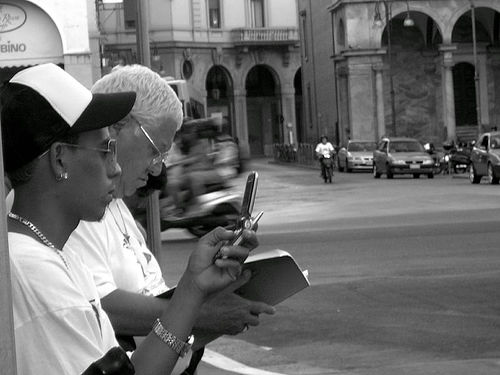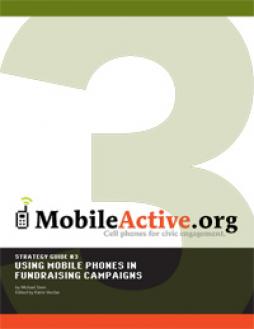sms campaigns
Posted by KatrinVerclas on Mar 24, 2007
MobileActive is announcing the third MobileActive Guide, profiling strategies and civil society organizations using mobile phones in their work to make the world a better place. The MobileActive Guide focuses on using mobile phones in fundraising campaigns. It features case studies from around the world, strategies for using mobile phones in fundraiaing, and a how-to section for organizations considering using mobile phones to support their causes.
Download the Guide here.Mobile phones have become a powerful emerging tool for participation in civil society. This five part series looks ways nonprofits have used mobile phones in their campaigns and the effective strategies deployed, and shares lessons learned.
Posted by KatrinVerclas on Jan 24, 2007
 I am part of a research project for the Gates Foundation on the future of global online advocacy, where I have been adding data and commentary on mobile content. One of the ideas we have floated is a global SMS hub – a commercial aggregator for low cost global SMS campaigns.
I am part of a research project for the Gates Foundation on the future of global online advocacy, where I have been adding data and commentary on mobile content. One of the ideas we have floated is a global SMS hub – a commercial aggregator for low cost global SMS campaigns.
Why is this needed?
SMS is a critical tool for e-advocacy in the global south. Given the high rates of mobile phone penetration in large parts of the world compared to Internet access, SMS allows a much wider reach than email. However, mass SMS campaigns are not feasible option for many NGOs in the global south because of cost – costs that pertain both to the NGO itself and to potential campaign participants who must pay to text. Sending an email message (or a thousand) entails no excess cost for an NGO above the cost of an internet connection (which admittedly, can be formidable in some parts of the world). However, if an NGO sends an SMS, it must pay per message (the global average cost is .10 US $), making mass texting thousands of messages prohibitively expensive. In addition, SMS is in some countries still relatively expensive for consumers, making it somewhat unlikely that they would send an SMS message on behalf of an advocacy campaign.
What would reduce the cost of SMS for social causes and allow for mass sms campaigns to become a reality for NGOs engaging their constituents?
What is needed is a global SMS hub for civil society organizations, and possibly even one with toll-free numbers for SMS that would not charge participants. With a toll-free SMS short code, the sender would not have to pay to send the SMS to a particular number or better yet short code. This would require short code requisition for many countries and agreements with all telephone operator in the country (or countries) in which the service is to be offered -- short, a global aggregator service with a twist, a Clickatell for Good.
How far off from being a reality is a global SMS hub for civil society?
The GSM Association recently completed trials of a hub-baed interoperability structure. From it’s press release:
Posted by MohiniBhavsar on Sep 16, 2010
The Role of Digital Networked Technologies in the Ukrainian Orange Revolution data sheet 2122 Views
Abstract:
This working paper is part of a series examining how the Internet influences democracy. This report is a narrative case study that examines the role of the Internet and mobile phones during Ukraine's 2004 Orange Revolution. The first section describes the online citizen journalists who reported many stories left untouched by "self-censored" mainstream journalists. The second section investigates the use of digital networked technologies by pro-democracy organizers. This case study concludes with the statement that the Internet and mobile phones made a wide range of activities easier, however the Orange Revolution was largely made possible by savvy activists and journalists wililng to take risks to improve their country.
Posted by MohiniBhavsar on Sep 16, 2010
Digitally Networked Technology in Kenya's 2007-2008 Post-Election Crisis data sheet 2144 Views
Author:
Joshua Goldstein and Juliana Rotich
Abstract:
Written largely through the lens of rich nations, scholars have developed theories about how digital technology affects democracy. However, primarily due to a paucity of evidence, these theories have excluded the experience of Sub-Saharan Africa, where meaningful access to digital tools is only beginning to emerge, but where the struggles between failed state and functioning democracy are profound. Using the lens of the 2007–2008 Kenyan presidential election crisis, this case study illustrates how digitally networked technologies, specifically mobile phones and the Internet, were a catalyst to both predatory behavior such as ethnic-based mob violence and to civic behavior such as citizen journalism and human rights campaigns.
The paper concludes with the notion that while digital tools can help promote transparency and keep perpetrators from facing impunity, they can also increase the ease of promoting hate speech and ethnic divisions.
Posted by KatrinVerclas on Mar 31, 2008
TxtMob, a group SMS service and its creator, Tad Hirsch, a long-time MobileActive colleague, have ben subpoenaed by the city of New York to turn over information about TxtMob users and activists who participated in the 2004 protests against the Republican National Convention there.
In a blow to privacy and a chilling development to activists, the city, involved in a law suit, has requested that information about text messages, phone numbers, and other personal information is turned over to the city. Support is needed, so please go to TxtMob and donate.
It's worth quoting this New York Times article in its entirety:

 I am part of a research project for the Gates Foundation on the future of global online advocacy, where I have been adding data and commentary on mobile content. One of the ideas we have floated is a global SMS hub – a commercial aggregator for low cost global SMS campaigns.
I am part of a research project for the Gates Foundation on the future of global online advocacy, where I have been adding data and commentary on mobile content. One of the ideas we have floated is a global SMS hub – a commercial aggregator for low cost global SMS campaigns. 